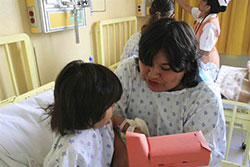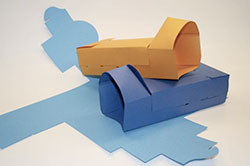It became known as the “baby bong project.”
Stanford University students looking for cost-effective ways to build inhalers for impoverished children in Latin America stumbled upon an unorthodox method during their research process: How-to guides on the Internet explaining how to construct a bong out of a water bottle, apple and other cheap household items. It turns out that the same common, low-cost materials popular for creating tools for illegal drug use were also useful for designing medical equipment for communities in developing countries.

Turning a Crazy Idea into a Lifesaving Device
What sounded like a crazy idea became the “Spacemask Spacer,” a $1 paper device that facilitates delivery of aerosolized asthma medication to children.
The students, who were enrolled in an interdisciplinary course called “Entrepreneurial Design for Extreme Affordability,” discovered the need for the spacing device through their fieldwork at rural health clinics in Mexico. The local doctor could diagnose asthma symptoms and had medication to treat it, but didn’t have a spacing device to make sure asthma medication was properly dispensed to the lungs of a child. So children having an asthma attack had to travel hundreds of miles to an urban hospital to receive treatment.

The spacing device, manufactured from a single sheet of paper that has a simple system of cuts and folds, may improve the respiratory health of more than 140 million children worldwide. The “baby bong project” is just one example of how a low-cost innovation can change lives, said James M. Patell, Herbert Hoover Professor of Public and Private Management at Stanford’s Graduate School of Business.
Patell was a keynote speaker at the University of Utah Center for Global Surgery's 2013 Extreme Affordability Conference, which brought together surgeons, anesthesiologists, nurses, engineers, and financial experts to figure out ways to lower costs and improve access to surgical care in developing countries through innovations in technology and surgical systems.
Beyond Volunteerism: Global Surgery Solutions
“There are certain kinds of health care problems that can only be addressed by surgery. They can’t be addressed by medication, vaccinations or any other kind of care,” says Catherine deVries, M.D., professor of urologic surgery at the University of Utah School of Medicine and director of the Center for Global Surgery. “In order for medically underserved areas to gain access to affordable and sustainable surgical care, there must be an effort that extends beyond surgeons donating their time and skills to perform operations.”
deVries believes that surgery must be thought of in a "holistic sense” that goes beyond the medical point of view. Business, engineering, law, economy and public policy must also be considered when brainstorming how to bring better surgical care to struggling countries. Vivian S. Lee, M.D., senior vice president for health sciences at the University of Utah, agrees with deVries that we have a responsibility to seek solutions that improve health care worldwide. “Surgery that saves lives and improves the quality of life is not available to billions of people in many parts of the world. There are myriad reasons for this—costs, lack of infrastructure, and crippling shortages of trained health care professionals,” Lee said at the conference. She believes the benefits of pursuing these solutions are a two-way street. “Innovations that make surgery cheaper and more available to people in far-flung regions of the world might well be applied to the United States.”
Student Brainpower Fuels Innovation
Patell believes that interdisciplinary groups of students may be the most promising resource to come up with these solutions. “Education programs that combine entrepreneurship have the power to change medicine across the world,” Patell said. His program at Stanford is part of a growing trend. The University of Utah hosts an annual Bench to Bedside Medical Device Concept and Design Competition, that brings medical, engineering and business students together to compete to make a medical device concept or novel improvement of a current medical device.
The key is to quickly make a prototype and turn to another idea if it doesn’t work. “You have to become better at doing than thinking,” he said. “Innovation is not an event,” he added. “It’s a process, a regular course of action taking place in a defined manner.”
For more on the Extreme Affordability Conference, visit:
Want a taste of some of the lectures presented at this spring’s event? Check out these YouTube videos:
Wondering about global surgery's focus on accessibility, affordability, and innovation? Check out these U. experts’ take on the issue:
More on Stanford's "Entrepreneurial Design for Extreme Affordability" and The University of Utah's "Bench to Bedside" competition